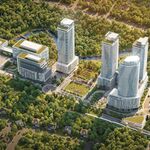SlickFranky
Active Member
Because subways often come with parallel bus service with narrow stop spacing.
Do they? Our subways have tons of intersecting bus routes, but there are very few routes that run parallel for more than a few blocks.
Because subways often come with parallel bus service with narrow stop spacing.
Do they? Our subways have tons of intersecting bus routes, but there are very few routes that run parallel for more than a few blocks.
^ Right. So that 80 year old Chinese man who's pushing his cart full of groceries counts as "old, fat, lazy, immobile"?
We have an aging population, who will find it challenging to deal with 400m stop spacing...particularly in the winter. And seniors deserve sympathy not scorn.
That's when you increase Wheel Trans funding.
For the rest of us. Don't think about it, just walk it. It's not like braving the elements will kill if you have to walk 500 or so metres....
^ Right. So that 80 year old Chinese man who's pushing his cart full of groceries counts as "old, fat, lazy, immobile"?
We have an aging population, who will find it challenging to deal with 400m stop spacing...particularly in the winter. And seniors deserve sympathy not scorn.
Funnily enough, my grandmother was in her 80s, and living east of Sheppard & Bayview when the subway there opened. She used to catch the bus a lot before 2002 which would be frequent and only a few steps from her home, but once the subway opened, the bus service was cut dramatically, and Bayview station was too much of a walk for her.
Now, that doesn't mean that it would have been much better if LRT was there, but I can say for certain that the subway didn't improve her situation.
Is this seriously an argument for trams over subways?
^ Right. So that 80 year old Chinese man who's pushing his cart full of groceries counts as "old, fat, lazy, immobile"?
We have an aging population, who will find it challenging to deal with 400m stop spacing...particularly in the winter. And seniors deserve sympathy not scorn.
Funnily enough, my grandmother was in her 80s, and living east of Sheppard & Bayview when the subway there opened. She used to catch the bus a lot before 2002 which would be frequent and only a few steps from her home, but once the subway opened, the bus service was cut dramatically, and Bayview station was too much of a walk for her.
Now, that doesn't mean that it would have been much better if LRT was there, but I can say for certain that the subway didn't improve her situation.
Yeah, and most of the reason they pushed so hard for 100% low-floor is so they could cut back on Wheel Trans eventually - it's an incredibly inefficient way to spend transit dollars.
The subway didn't improve her situation because it wasn't going where she needed it to go. That's a different issue. What the subway didn't do is make her situation worse. The LRT is removing bus stops. That's actually a downgrade for people who have mobility issues. Is it that difficult to acknowledge that some people might have problems walking 200m?
There's a Yonge bus and and a Sheppard bus. However, there's no daytime Bloor-Danforth bus and no Spadina-University bus at all.
54 Lawrence East will likely continue to provide local service on Eglinton between Yonge and Leslie.
It sounds more like she (kettal's grandmother) had a bus stop right near her house and now she doesn't. That's literally a case of the subway making someone's situation worse.




